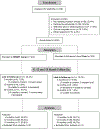Effects of the HEART Camp Trial on Adherence to Exercise in Patients With Heart Failure
- PMID: 30010027
- PMCID: PMC7197231
- DOI: 10.1016/j.cardfail.2018.06.007
Effects of the HEART Camp Trial on Adherence to Exercise in Patients With Heart Failure
Abstract
Background: Few exercise training studies in patients with heart failure (HF) report adherence to guideline-recommended 150 minutes of moderate-intensity exercise per week, and no studies have focused on a primary outcome of adherence.
Methods and results: This randomized controlled trial evaluated the effect of a multicomponent intervention, Heart Failure Exercise and Resistance Training (HEART) Camp, on adherence to exercise (after 6, 12, and 18 months) compared with an enhanced usual care (EUC) group. Patients (n = 204) were 55.4% male, overall average age was 60.4 years, and 47.5% were nonwhite. The HEART Camp group had significantly greater adherence at 12 (42%) and 18 (35%) months compared with the EUC group (28% and 19%, respectively). No significant difference (P > .05) was found at 6 months. The treatment effect did not differ based on patient's age, race, gender, marital status, type of HF (preserved or reduced ejection fraction) or New York Heart Association functional class. Left ventricular ejection fraction (LVEF) significantly moderated the treatment effect, with greater adherence at higher LVEF.
Conclusions: The multicomponent HEART Camp intervention showed efficacy with significant effects at 12 months and 18 months. Adherence levels remained modest, indicating a need for additional research to address methods and strategies to promote adherence to exercise in patients with HF.
Keywords: Exercise; adherence; exercise training; heart failure.
Copyright © 2018 Elsevier Inc. All rights reserved.
Figures
References
-
- Heart Failure Society of America, Lindenfeld J, Albert NM, et al. HFSA 2010 comprehensive heart failure practice guideline. J Card Fail. 2010;16(6):e1–194. - PubMed
-
- van der Wal MH, van Veldhuisen DJ, Veeger NJ, Rutten FH Jaarsma T. Compliance with non-pharmacological recommendations and outcome in heart failure patients. Eur Heart J. 2010;31(12):1486–1493. - PubMed
-
- Evangelista L, Doering LV, Dracup K, Westlake C, Hamilton M, Fonarow GC. Compliance behaviors of elderly patients with advanced heart failure. J Cardiovasc Nurs. 2003;18(3):197–206; quiz 207–8. - PubMed
-
- Gary R Exercise self-efficacy in older women with diastolic heart failure: Results of a walking program and education intervention. J Gerontol Nurs. 2006;32(7):31–9; quiz 40–1. - PubMed
-
- Rodriguez KL, Appelt CJ, Switzer GE, Sonel AF, Arnold RM. “They diagnosed bad heart”: A qualitative exploration of patients’ knowledge about and experiences with heart failure. Heart Lung. 2008;37(4):257–265. - PubMed
Publication types
MeSH terms
Grants and funding
LinkOut - more resources
Full Text Sources
Other Literature Sources
Medical
Research Materials
Miscellaneous




